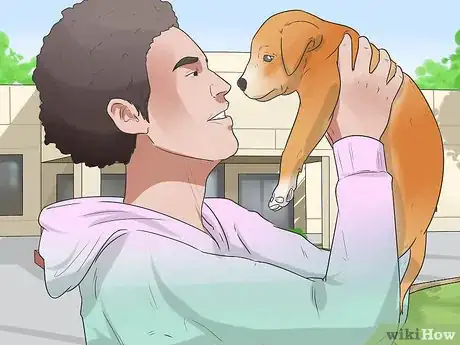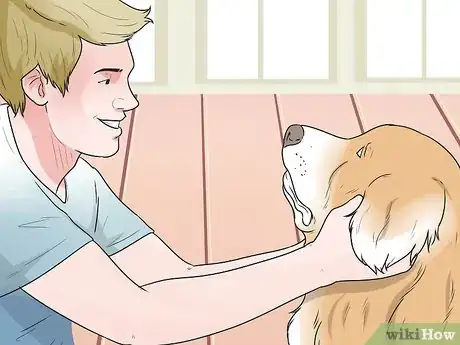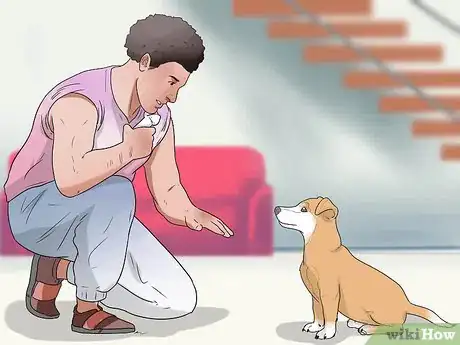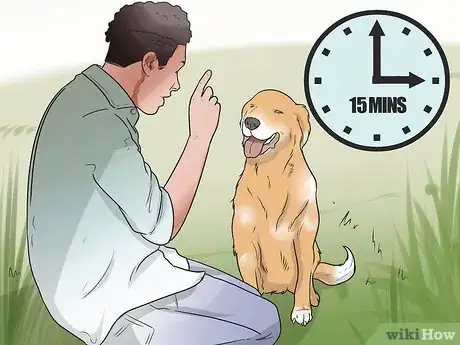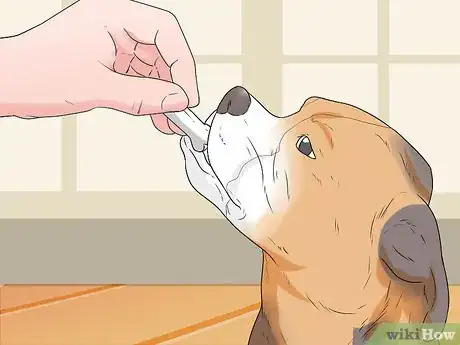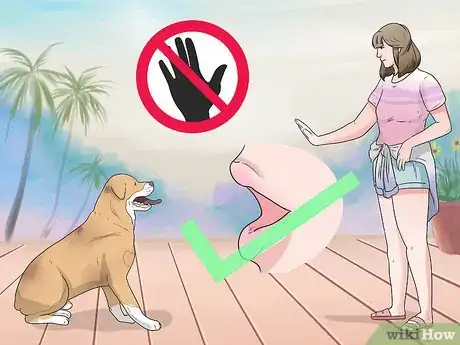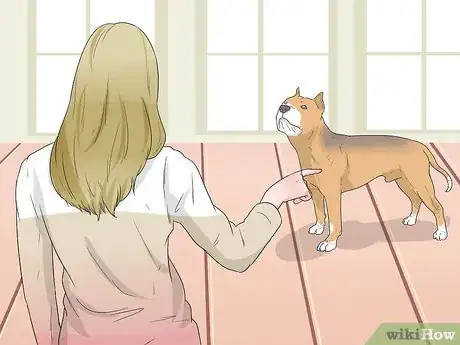This article was co-authored by Brian Bourquin, DVM. Brian Bourquin, better known as “Dr. B” to his clients, is a Veterinarian and the Owner of Boston Veterinary Clinic, a pet health care and veterinary clinic with three locations, South End/Bay Village, the Seaport, and Brookline, Massachusetts. Boston Veterinary Clinic specializes in primary veterinary care, including wellness and preventative care, sick and emergency care, soft-tissue surgery, dentistry. The clinic also provides specialty services in behavior, nutrition, and alternative pain management therapies using acupuncture, and therapeutic laser treatments. Boston Veterinary Clinic is an AAHA (American Animal Hospital Association) accredited hospital and Boston’s first Fear Free Certified Clinic. Brian has over 19 years of veterinary experience and earned his Doctor of Veterinary Medicine from Cornell University.
This article has been viewed 36,824 times.
Voice commands allow you to control your dog even when it is out of sight. Your dog's responsiveness to voice commands will help you handle your dog in outdoor situations, increase your neighbors' tolerance of your pet, and even save your animal's life in a dangerous situation. Voice commands can also help a child or a smaller adult control a large dog. Prepare your dog and your household for successful training. Then, follow a few simple steps to help your dog learn to respond to voice commands.
Steps
Setting the Groundwork for Successful Training
-
1Become a benevolent leader. Your dog needs to recognize you as the alpha, or pack leader, before it will take your training commands seriously. Undertaking leadership exercises with your dog will help it understand that you are in control and deserve its trust and respect. Dogs are naturally pack animals; your dog will be quite willing to cede you authority once it recognizes you as its leader. Try one or more of the following exercises:
-
2Set ground rules early and stick to them. Ensure everyone in your household is on the same page. Consistency is key to establishing a successful training regimen.Advertisement
-
3Plan to practice frequently. Commit yourself to work daily with your dog. You'll need to repeat most commands many times before your dog is fully trained.
-
4Remember that a happy owner makes for a happy dog. Your mood transfers readily to your dog. If you are tired or agitated, your dog will pick up on these cues. She'll be less likely to obey, and likely become frustrated and tired herself. Wait to hold a training session until you're feeling calm and in a good mood.
Developing Your Voice Commands
-
1Speak at a normal voice volume. Yelling tells your dog that you're tense, upset, or otherwise out of control. These cues fail to inspire confidence or trust. Remember, you need to be the alpha figure in your relationship with your dog. Speaking at a normal volume level helps establish your command of the situation.
-
2Select clear, concise commands. The specific commands you choose are less important than their clarity, although once you've chosen it is important to be consistent.[1] Recognize, however, that using more common commands may help in situations where someone else may need to issue a command for the safety of your dog or those around her. Also make sure your dog understands his or her name. The most common dog commands include:
- Watch me
- Sit
- Stay
- Down (as in lie down)
- Off (as in get off me or the furniture)
- Stand
- Come
- Heel (walk close to my side)
- Leave it[2]
-
3Pay attention to your tone. As you determine which voice commands to use with your dog, recognize that your tone delivers an equally important message.
- Use a higher-pitched, more excited tone of voice to deliver praise and issue active commands ("Come!" "Good dog!"). Dogs hear these tones as encouraging or enthusiastic.
- Use a low-pitched, growly tone to issue corrections and commands that don't involve movement ("Off!" "Stay!"). Dogs respond to low-pitched or growling noises with caution or acquiescence.
- You might try a low-pitched, flat or slowly descending tone of voice for a command such as "Stay!" that requires some authority, but less correction.[3]
Teaching Your Dog to Respond
-
1Keep training sessions short and sweet. Now that you have prepared your household and selected your commands for training, you can begin the work of teaching your dog that "Come!" means "Come!" Set aside time each day for training, but remember that dogs have limited attention spans. Limit training sessions to 15 minutes or less.
- Introduce new voice commands one at a time.
- Keep expectations realistic. Try working on one component of a behavior. If you want your dog to sit and then stay when you walk away from him, start by training your dog to sit quietly while you remain nearby. Over time you can train him to remain sitting while you walk away.
- Start with just a few seconds of compliance and then work up over time. For example, you may work with your dog to "stay" for five seconds over the course of one week and then work on a ten-second "stay" the next. Begin working on a command to "come" by encouraging your dog to travel just a few yards; over time, you can develop her ability to respond over greater distances or around a corner.
- Voice commands are essentially habits, and as with establishing any good habit, repetition is essential. Try doing five to 15 repetitions of one behavior before moving on to the next command.[4]
EXPERT TIPDr. Elliott, BVMS, MRCVS is a veterinarian with over 30 years of experience in veterinary surgery and companion animal practice. She graduated from the University of Glasgow in 1987 with a degree in veterinary medicine and surgery. She has worked at the same animal clinic in her hometown for over 20 years.Veterinarian
 Pippa Elliott, MRCVS
Pippa Elliott, MRCVS
VeterinarianPippa Elliott, a licensed veterinarian, adds: "It's perfectly fine to lure the dog with a treat to get the desired action. Just be sure to use a voice command at the same time (like "Sit"), and then gradually phase out the lure."
-
2Reward your dog for good behavior.[5] Use positive reinforcement as a training tool to ensure your dog understands when he's responding well to your commands.
- Most dogs are highly food-motivated, so food can be an especially attractive reward. Experiment to see what works best for your pet, but keep food rewards small so you can use them repeatedly: a soft piece of food, doggie treat, or small square of cheese. Avoid hard foods that she'll need to break apart; you want to ensure she associates the reward with her behavior, and the process of eating a more complicated food could distract her.
- Couple food rewards with verbal rewards. Praise your dog each time she responds well to your voice command.
- Consider non-food treats such as a favorite toy, a scratch on the head, or brief playtime (ideally toward the end of a training session).[6]
- Over time, reduce the frequency of food rewards. Cut back to three out of four times the dog performs a given behavior, then two out of four, and so on. Be sure to keep selective rewards random, however. Dogs can be quite smart -- you don't want her to figure out she need only comply every other time!
- Continue to respond with verbal praise each time your dog obeys.[7]
-
3Stick to voice-only commands. Using touch at the same time as you issue a voice command can confuse your dog. Her sense of touch will always been more important than your voice command. Consequently, she'll be less likely to respond to your voice command alone.[8]
-
4Ensure that when you deliver a voice command you can make the dog obey. If you aren't willing to get up and physically make your dog follow your instructions, refrain from issuing a voice command. Otherwise, you'll teach your dog that your command is optional.[9]
-
5Practice voice commands in different environments. Ensure your dog is safe in any training environment before you begin, but practice issuing commands in different places and around distractions such as people and other pets. This way your dog will learn that "come" or "stay" means the same thing in all situations, and not just in the comfort of your backyard or local park.[10]
-
6Capitalize on any opportunity to reinforce good behavior. Keep an eye on your puppy, and as she starts to sit, repeat the command "sit." If she then turns and makes eye contact, deliver a verbal reward such as "good girl." Over time, she'll learn to associate the sound "sit" with sitting down, and realize that if you say that word and she sits she'll receive praise.
References
- ↑ http://www.raisingspot.com/training/dog-training-basics-commands
- ↑ http://www.humanesociety.org/animals/dogs/tips/dog_training_positive_reinforcement.html
- ↑ http://www.raisingspot.com/training/dog-training-basics-commands
- ↑ https://www.aspca.org/pet-care/virtual-pet-behaviorist/dog-behavior/training-your-dog
- ↑ Brian Bourquin, DVM. Veterinarian. Expert Interview. 20 December 2019.
- ↑ http://www.humanesociety.org/animals/dogs/tips/dog_training_positive_reinforcement.html
- ↑ http://www.humanesociety.org/animals/dogs/tips/dog_training_positive_reinforcement.html
- ↑ http://www.raisingspot.com/training/dog-training-basics-commands
- ↑ http://www.raisingspot.com/training/dog-training-basics-commands
About This Article
To train your dog to respond to voice commands, make sure you use short, clear commands like, “Sit, “Stay,” and “Down,” to make things as simple as possible for your dog. When you give a command, speak at a normal volume to avoid confusing it. If your dog doesn’t listen to you, you should always get up and physically make it follow your command so it doesn’t get the impression that commands are optional. When your dog does what you want, reward it with praise and treats to reinforce positive behavior. It’s also important to train your dog in different environments so it understands that “Come,” or “Stay” means the same thing anywhere and not just in your back yard. For more tips from our Veterinary co-author, including how to use the right tone of voice when giving your dog commands, read on!
